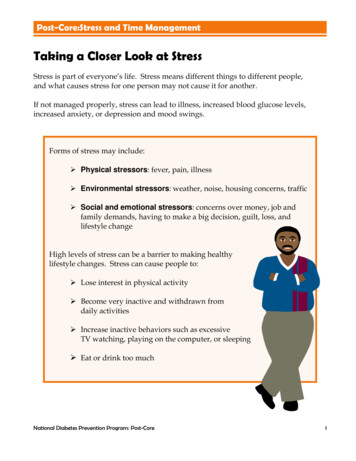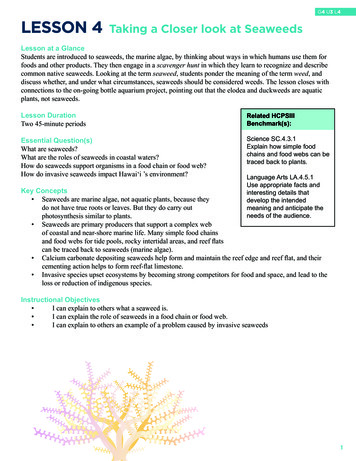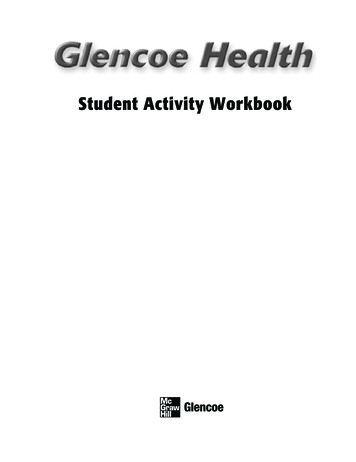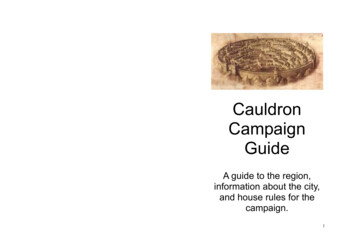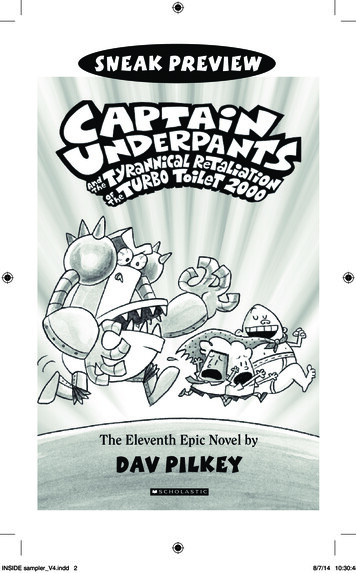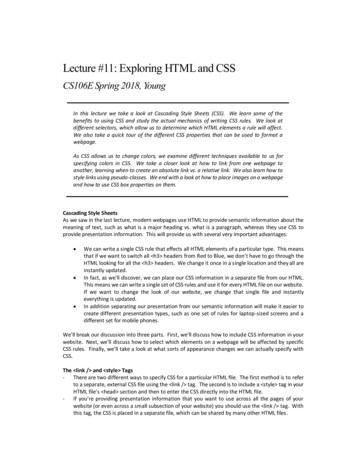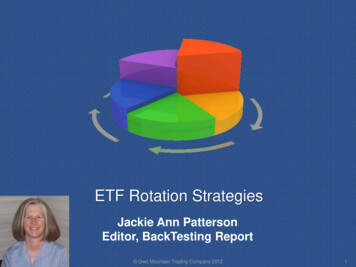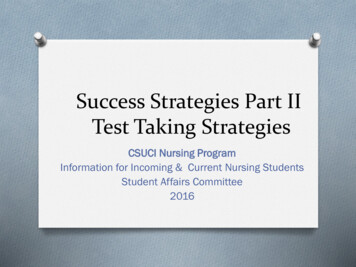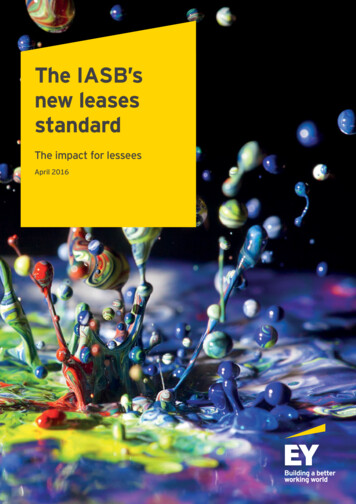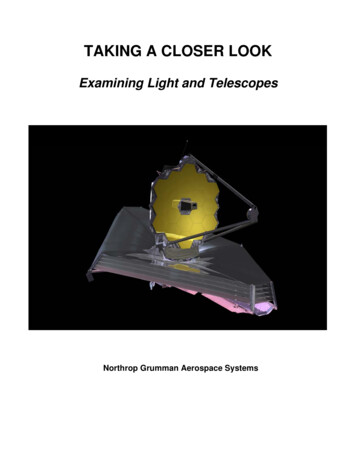
Transcription
TAKING A CLOSER LOOKExamining Light and TelescopesNorthrop Grumman Aerospace Systems
Taking a Closer LookTable of ContentsSectionOverviewSuppliesStandards MatrixContent BackgroundTelescope DescriptionsActivity #1 – What Does a Telescope Do?Activity #2 – Bouncing LightActivity #3 – Focusing LightActivity #4 – Using TelescopesWorksheetSample worksheet answersDisplay CardsHow Does A Telescope Work? PosterJames Webb Space Telescope PosterChandra X-ray Observatory PosterTAKING A CLOSER LOOKPage3456910111213141618192021Page 2 of 21
OVERVIEWBrief Description of the ActivityIn Taking a Closer Look, students will explore how lenses gather and focus light byexamining images using magnifying glasses and telescopes.Appropriate AgesTaking a Closer Look is appropriate for students in grades 3 to 9.TimeTaking a Closer Look can be presented in approximately 1 hour.Preparation Prior to PresentationAssemble the telescopes students will be using during the activity. Tape a strawalong the top of the telescopes to use as a sighter, being careful to only tape thestraw to one of the two tube parts.Practice with the telescopes to get a feel for how they operate and where the focusis. Draw a line on the telescope tube at the focus position.Read and become familiar with the background information presented in this activity.Be able to explain how magnifying glasses and mirrors bend light to create a virtualimage, and how refracting telescopes gather and bend light to create a magnifiedimage of a distant object.Student OutcomesStudents should be able to explain that:1) Mediums such as water, glass and plastic focus, or refract, light.2) Surfaces such as mirrors bounce, or reflect, light. We see most things around usbecause of the light reflected off them.3) Telescopes work by gathering light with either a lens or a mirror and creating amagnified image.During the presentation of Taking a Closer Look, review the above concepts oftenwith the students. The Northrop Grumman handouts can be used to reward correctanswers or insights about the primary ideas.TAKING A CLOSER LOOKPage 3 of 21
SUPPLIESMaterials for Each StudentTelescope WorksheetOne set of colored pencils, 4 to 8 pencils per setOne assembled telescopeMaterials for Each Student Group1 clear drinking glass1 brightly colored straw1 Chandra poster1 JWST poster1 locker mirrorMaterials for the Presenter33 telescopes, one disassembled and displayed in a box8 magnifying glasses1 plastic bucket8 clear plastic drinking glass1 bottle of water40 brightly colored straws2 small How Does a Telescope Work? display cards1 large How Does a Telescope Work? display card2 MOM cards for display, positioned between 5 and 10 yards from the where thestudents will be standing1 large poster of the current project for display (e.g. large JWST poster)30 Northrop Grumman handouts to present to studentsTelescope Purchasing InformationThe following telescope kits are available from www.starlab.comPS-04B: Refracting Telescopes (set of 10 bulk) - 50.00PS-04B/Single: 1 Complete Telescope Kit - 9.00The 10-Telescope Kit includes (10 of each unless noted): foam holders, cardboard spacers and washers for the eyepiece lenses red plastic caps, cardboard spacers for the objective lenses plastic lenses (43mm diameter, objective, 400mm focal length) plastic lenses (17.5mm diameter, 25mm focal length) inner and outer tubes 1 set of instructions & activitiesTAKING A CLOSER LOOKPage 4 of 21
STANDARDS MATRIXThis activity aligns with the California science content standards.KindergartenInvestigation and Experimentation 4 a,b,c,eGrade 1Investigation and Experimentation 4 a,bGrade 2Investigation and Experimentation 4 a,gGrade 3Investigation and Experimentation 4 gGrade 4Physical Sciences 2 b,dInvestigation and Experimentations 5 gGrade 7Physical Sciences 6 b,c,d,f,gGrades 9-12Investigation and Experimentation 1 dThis activity supports the following national science content standards.Grades K-4Content Standard A: Science as InquiryContent Standard B: Physical ScienceContent Standard E: Science and TechnologyGrades 5-8Content Standard A: Science as InquiryContent Standard E: Science and TechnologyGrades 9-12Content Standard A: Science as InquiryTAKING A CLOSER LOOKPage 5 of 21
SCIENCE CONTENTHistory of TelescopesThe invention of the telescope is often attributed to Hans Lippershey, an optician who,in 1608, aligned two lenses of different curvatures and focal lengths. It is not known howGalileo Galilei heard of the process, but there is evidence that Galileo quickly bought orground his own lenses and made a simple telescope that he demonstrated in 1610 tothe Senate in Venice. Galileo is credited with discovering four of Jupiter’s moons, craterwalls on Earth’s moon, Venus’ phases, sunspots, and Saturn’s rings. The telescope thatGalileo designed over 400 years ago is very similar to the ones students will be using inthis activity.Regardless of type and complexity, all telescopes operate in basically the same way.Telescopes capture light and provide a detailed image to the viewer. Our eyes aretelescopes, as are cameras, satellite dishes and radio telescopes.How Do Telescopes Work?Telescopes have two main parts: the first lens and the second lens. The first lens iscalled the objective lens and the second lens is called the eyepiece. Telescopes thatuse only lenses are called refracting telescopes, or refractors. The telescopes used inthis activity are refractors. Some telescopes use a mirror, called the primary mirror, inplace of the first lens. These are called reflecting telescopes, or reflectors. Mostprofessional telescopes are reflectors.The objective lens (or primary mirror in reflectors) collects light from a distant object andbrings it to a point or focus. The image is bent, or focused, on a small surface called thefocal plane. The eyepiece is a magnifying glass. It focuses the light from the image atthe focal plane so the observer sees a larger, magnified image.A typical refractorRefractorFocus-Incoming light is bentinto a bright point.Objective Lens-Gathers light andbends it into focus.Pupil of the EyeEyepieceIncoming Light-Brings the bright image fromthe focus and magnifies it tothe size of your eye’s pupil.Image from mImage from KING A CLOSER LOOKPage 6 of 21
Most professional telescopes are reflectors. The main advantage of reflectors is thatthey can be made very large because the back of the mirror can be supported. Anotheradvantage of reflectors is that there is no chromatic aberration, a feature of refractorswhere the different wavelengths of light pass through the lens at different speeds andproduce a rainbow-like halo around the image. A third advantage of reflectors is thatonly one side of the objective (the reflecting side of the primary mirror) needs to be theright shape and smoothness to reflect the light. Because light passes through a lens,however, it needs to be perfectly shaped on both sides.Reflectorprimary mirroreyepieceHow Does a Magnifying Glass Work?Magnifying glasses work by focusing light to create a virtual image in a location otherthan it would appear if the light were not focused. Just like you can see a “virtual you”who appears to stand back in the depths of a mirror, an observer sees a larger, virtualimage cast by the light bent through a magnifying glass. The real image is cast on theobserver’s retina, not out beyond the focal plane. To the observer, however, the imageappears to be some distance beyond the surface of the magnifying glass. Magiciansoften take advantage of virtual images to make objects seem to appear in a seeminglyempty box, or to look like they are hovering in mid air.TAKING A CLOSER LOOKPage 7 of 21
Professional TelescopesAstronomers use telescopes (mostly reflectors) that observe across all wavelengths oflight, from low-energy radio and microwave light to high-energy gamma rays and x-rays.The image below is of the complete light spectrum.There are posters of two telescopes included in this activity, the Chandra X-rayobservatory and the James Webb Space Telescope (JWST). Northrop Grumman SpaceTechnology (NGST) is the primary manufacturer of both Chandra and JWST. TheChandra X-ray observatory observes x-ray light and the James Webb Space Telescopewill observe primarily in infrared light.JWSTCHANDRAQuickTime and aTIFF (Uncompressed) decompressorare needed to see this picture.QuickTime and aTIFF (Uncompressed) decompressoare needed to see this picture.The James Webb Space Telescope. Notice thelarge golden primary mirror. JWST is a reflectorand will observe mostly infrared light.The Chandra X-ray Observatory. Notice the tubeextending perpendicular to the solar panels. Chandrais a refractor and observes X-ray light.More information on telescopes and optics can be found in the content section of theBringing It Closer module at www.science-fest.org.TAKING A CLOSER LOOKPage 8 of 21
TELESCOPE DESCRIPTIONSJames Webb Space TelescopeThe James Webb Space Telescope is a largespace telescope scheduled for launch in 2013.JWST is designed to study the earliest galaxiesand some of the first stars formed after the BigBang. JWST's instruments will be designed towork primarily in the infrared range of theelectromagnetic spectrum, with some capability inthe visible range. JWST will have a large mirror,6.5 meters (20 feet) in diameter and a sunshieldthe size of a tennis court. Both the mirror andsunshade won't fit onto the rocket fully open, soboth will fold up and open only once JWST is inouter space.JWSTThe James Webb Space Telescope. Notice thelarge golden primary mirror. JWST is a reflectorand will observe mostly infrared light.The Chandra X-ray ObservatoryNASA's Chandra X-ray Observatory waslaunched and deployed by Space ShuttleColumbia on July 23, 1999. Chandra detectsand images X-ray sources that are billions oflight years away. The images Chandra makesare twenty-five times sharper than the bestprevious X-ray telescope. This focusing power isequivalent to the ability to read a newspaper ata distance of half a mile. Chandra is used tostudy black holes, supernovas, exploded stars,and dark matter. Chandra will increase ourunderstanding of the origin, evolution, anddestiny of the universe.TAKING A CLOSER LOOKQuickTime and aTIFF (Uncompressed) decompressoare needed to see this picture.The Chandra X-ray Observatory. Notice the tubeextending perpendicular to the solar panels. Chandrais a refractor and observes X-ray light.Page 9 of 21
ACTIVITY #1 – What Does a Telescope Do?The intent of this activity is for students to enact the processes used by a telescope togather light and create a magnified image.Directions for the Presenter1. Hold up an assembled telescope and explain to the students that today we’re goingto learn about how telescopes work.2. Take out the objective lens and hold it up. State: “First we have the objective lens. Itcatches and focuses light.” At the same time making a catching motion with yourhands, then crossing your arms to show light focusing.3. Ask students to repeat back to you what comes first.4. Take out the eyepiece lens and hold it up. State: “Then we have the eyepiece. Itmagnifies the image.” At the same time spread your arms to show magnification.5. Ask students to repeat back to you what comes second.6. Repeat the motions with the class several times.7. Ask the students what comes first and second throughout the presentation to remindstudents how a telescope works.8. Distribute the worksheets and colored pencils to the students. Ask students tocomplete question #1 on the worksheet, tracing the light path for a refractor.9. Explain that there are two types of telescopes: Reflectors and Refractors. Refractorsuse lenses to catch the light and focus, or refract it. Reflectors use mirrors to catchand bounce, or reflect, it.10. Hold up the telescope and explain that this is a refractor because it uses a lens.11. Hold up a picture of JWST and point to the mirror, stating that it is a mirror. Ask astudent if JWST is a reflector or a refractor.12. Repeat the motions used earlier, this time replacing “objective lens” with “primarymirror” and “focus” with “bounces.” Cross and bounce your arms to show lightbouncing off the mirror.13. Repeat the motions for both reflectors and refractors with the class several times.TAKING A CLOSER LOOKPage 10 of 21
ACTIVITY #2 – Bouncing LightThe intent of this activity is for students to observe how mirrors reflect light.Directions for the Presenter1. Hold up a mirror at arm’s length and face it, standing sideways to the class so theycan see your face and part of the reflection.2. Ask students to describe to you what you will see in the mirror. Ask them to describewhich side your right eye will appear on when viewed in the mirror.3. Explain that the light around you is bouncing off your face. Some of the light hits themirror. Because the mirror is very reflective, most of that light bounces back andgoes into your eye, so you see your reflection. Demonstrate how the light is movingby tracing your finger along the light path from your face to the mirror to your eyes.4. Explain that another word for bouncing is reflecting. Ask students to repeat“reflecting.”5. Ask a student to explain back to you why you can see your reflection in the mirror.Ask a student to come up and point out where the light is going as it bounces offyour face, off the mirror, and into your eye.6. Ask students to complete question #2 on the worksheet, tracing the light path fromthe mirror.7. Distribute the mirrors to the student groups.8. Ask the students to examine the mirrors and describe what they see. Pose thequestions “Which side of the mirror is your right/left eye on?” to help guide theirdescription.9. Ask a student to explain why her partner can see herself in the mirror, showing thelight as it bounces off her face and the mirror.10. Repeat with several other students.11. Ask students to complete question #3 on the worksheet, Draw an oval around thesmiley face that the observer sees using the lens. Draw a rectangle around thesmiley face the observer sees using the mirror.TAKING A CLOSER LOOKPage 11 of 21
ACTIVITY #3 – Focusing LightThe intent of this activity is for students to observe how water and lenses focus light.Directions for the Presenter1. Distribute the colored straws to the student groups.2. Ask the students to examine the straws and describe what theylook like to the other students in their group. Pose the question,“Are the straws straight or bent?” to help guide their description.3. Direct students to put their straws in their glasses and look atthem again. Direct students to describe the straws to the otherstudents in their group, again thinking about whether the strawappears straight or bent.4. Pour water into the glasses and ask students to examine the straws again. Askstudents to write a description of the straws in their worksheet, thinking aboutwhether the straw appears straight or bent.5. Ask the students: “What just happened?” Allow students to explore if the straw is infact bent, or if it just appears that way.6. Explain that water focuses, or refracts, light as it passes through the water. Thefocusing of the light is what makes it look like the straw is bent. This is also whatmakes images appear larger through a magnifying glass.7. Ask students to students to complete question #4 on the worksheet and draw thestraw in water on their worksheet.8. (Optional) Display the card with a triple sunset on it (Card 1 on page 18). Otheritems such as seeds, leaves, and rocks can also be used.8.1. Ask students what will happen when they look at the card through a magnifyingglass. Expected response: the picture will look bigger.8.2. Explain that magnifying glasses focus light, just like water. This is calledrefraction.8.3. Let the students hold the magnifying glass over the picture or display items andexamine the magnified image.TAKING A CLOSER LOOKPage 12 of 21
ACTIVITY #4 – Using TelescopesThe intent of this activity is for students to use telescopes to observe how lenses focuslight. Students will record and critically evaluate their observations.Directions for the Presenter1. Hold up the plastic bucket and ask students what buckets do. [Expected responses:collect water, hold stuff.]2. Ask students if they would like to look through a light bucket. Hold up the plasticbucket and the telescope and explain that first lens in a telescope acts just like abucket: it collects light. Just like a bucket with a bigger opening will collect morewater than a bucket with a smaller opening, a telescope with a bigger diametermiirror or lens with collect more light than a telescope with a smaller diameter mirroror lens.3. Point to the dissasembled telescope in the display box and explain that the first lensgathers the light from a distant object, then the second lens is a magnifying glassthat magnifys the image gathered by the first lens.4. Ask students to read the “MOM” card (Card 2 on page 18) displayed 5 to 10 yardsfrom where they are seated. Ask students to to complete #5 on their worksheet,taking care to put the colors in the order they appear on the card.5. Ask students to predict what will happen when they look at the card using atelescope. [Expected answers: “It will look bigger, it will be upside down.”]6. Hand students the telescopes and ask them to look at the “MOM” card and describewhat they see. [Expected response: “It says WOW!, The colors are flipped.”]Younger students may have trouble controlling the telescope and may requireassistance from presenters. Volunteers can guide students’ movements by tellingthem which direction to move the telescope so it’s pointing towards the “MOM” card.Students can look through the straw on top of the telescope to help locate the card,then look through the eyepiece.7. Ask students to draw what they see through the telescope in box #6 on theworksheet.TAKING A CLOSER LOOKPage 13 of 21
Name:Telescopes!Trace over the lines showing the light path from the smiley faceto the observer’s eye. Use a different color for each line.1) Trace the light path for the refractor.LENSEYEPIECEQuickTime and aTIFF (Uncompressed) decompressorare needed to see this picture.2) Trace the light path for the mirror.MIRRORQuickTime and aTIFF (Uncompressed) decompressorare needed to see this picture.3) What does the observer see?4) Draw a straw inside the glass filledwith water.Draw an oval around the smiley facethat the observer sees using the lens.Draw a rectangle around the smileyface the observer sees using themirror.QuickTime and aTIFF (Uncompressed) decompressorare needed to see this picture.a dna emiTkciuQrosserpmoced )desserpmocnU( FFIT.erutcip siht ees ot dedeen eraQuickTime and aTIFF (Uncompressed) decompressorare needed to see this picture.TAKING A CLOSER LOOKare needed to see this picture.TIFF (Uncompressed) decompressorQuickTime and aPage 14 of 21
5) Write the word you see with your eyes. Make sure to usethe correct colors and correct order!6) Write the word you see through the telescope. Make sureto use the correct colors and correct order!7) Use these words to fill in the blanks in the paragraph:larger lighteyepiece refraction telescopes bent magnifyingA straw in a glass of water looks like it is because waterfocuses light. This is called . Lenses also focus light. Aglass is a type of lens. A magnifying glass works by focusinglight from an object so it appears than it is. usetwo lenses, one in front of the other. The first lens gathersfrom a far-away object and focuses it to a small point. A second lens calledthe focuses the light from the small point made by the firstlens to make a larger image.TAKING A CLOSER LOOKPage 15 of 21
Name:Sample answersTelescopes!Trace over the lines showing the light path from the smiley faceto the observer’s eye. Use a different color for each line.1) Trace the light path for the refractor.LENSEYEPIECEQuickTime and aTIFF (Uncompressed) decompressorare needed to see this picture.2) Trace the light path for the mirror.MIRRORQuickTime and aTIFF (Uncompressed) decompressorare needed to see this picture.3) What does the observer see?4)Draw a straw inside the glassfilled with water.Draw an oval around the smiley facethat the observer sees using the lens.Draw a rectangle around the smileyface the observer sees using themirror.QuickTime and aTIFF (Uncompressed) decompressorare needed to see this picture.a dna emiTkciuQrosserpmoced )desserpmocnU( FFIT.erutcip siht ees ot dedeen eraQuickTime and aTIFF (Uncompressed) decompressorare needed to see this picture.TAKING A CLOSER LOOKare needed to see this picture.TIFF (Uncompressed) decompressorQuickTime and aPage 16 of 21
5) Write the word you see with your eyes. Make sure to usethe correct colors and correct order!MOM6) Write the word you see through the telescope. Make sureto use the correct colors and correct order!WOW7) Use these words to fill in the blanks in the paragraph:larger lighteyepiece refraction telescopes bent magnifyingA straw in a glass of water looks like it is bent because water focuseslight. This is called refraction . Lenses also focus light. A magnifyingglass is a type of lens. A magnifying glass works by focusing light from anobject so it appears larger than it is. Telescopes use two lenses,one in front of the other. The first lens gathers light from a far-awayobject and focuses it to a small point. A second lens called the eyepiecefocuses the light from the small point made by the first lens to make alarger image.TAKING A CLOSER LOOKPage 17 of 21
DISPLAY CARDSCard 1: An artist’s idea of view from a moon orbiting a planet in a triplestar system. For use with magnifying glassCard 2: For use with telescopesTAKING A CLOSER LOOKPage 18 of 21
HOW DOES A TELESCOPE WORK? POSTERHOW DOES A TELESCOPE WORK?QuickTime and aTIFF (Uncompressed) decompressorare needed to see this picture.EYEPIECEQuickTime and aTIFF (Uncompressed) decompressorare needed to see this picture.The first lensgathers lightand focuses itto a point.TAKING A CLOSER LOOKThe eyepiecemagnifies the lightby focusing it.The observer sees animage that is rotatedcompared to the originalobject.Page 19 of 21
TAKING A CLOSER LOOKPage 20 of 21
TAKING A CLOSER LOOKPage 21 of 21
TAKING A CLOSER LOOK Page 5 of 21 STANDARDS MATRIX This activity aligns with the California science content standards. Kindergarten Investigation and Experimentation 4 a,b,c,e Grade 1 Investigation and Experimentation 4 a,b Grade 2 Investigation and Experimentation 4 a,g Grade 3 Inves
